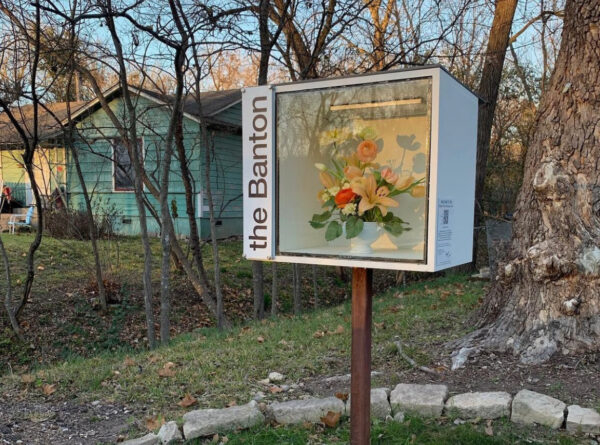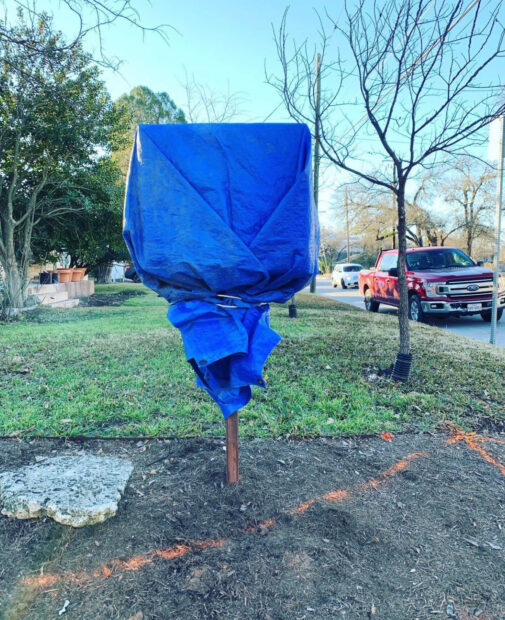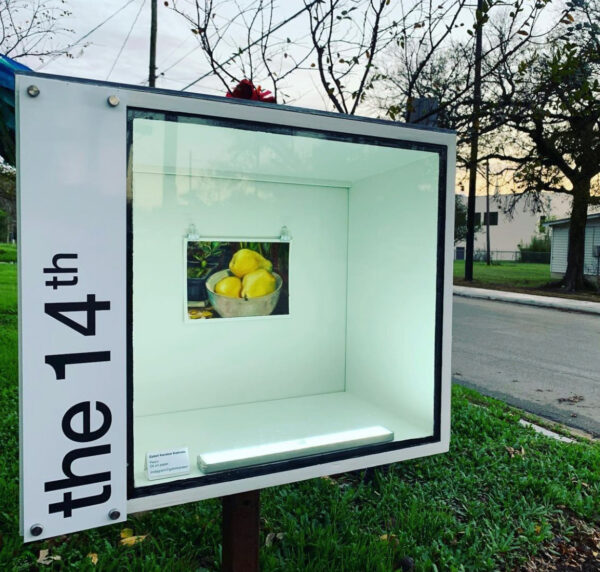Two white cubes first appeared in East Austin last November; each adorning an unassuming lawn, each containing minuscule art. The Banton (located at 3509 Banton Road) and The 14th (on the corner of E. 14th and Harvey Street) are the handiwork of artists Marianne Newsom and Juliet Whitsett — two plein-air pals looking to spruce up their blocks by thinking inside the box.
Really Small Museum ATX (RSM), as the project is called, is a 12-month art installation featuring a new show each month (and a few flashes in between). With the tagline “SMALL can be BIG,” RSM has won over spectators from Austin to Australia, where a tiny gallery in Adelaide is set to feature the two East Side micro museums on their Instagram feed.
Newsom and Whitsett are a true curatorial power couple, organizing exhibitions that range from abstract sculpture to mixed-media photography to eco-apothecaries — all within the confines of 16 x 20 x 12 inches. I recently had a chance to speak with the duo about Really Small Museum, possible plans to expand, and why teency weency art matters more than ever.
Barbara Purcell (BP): What inspired Really Small Museum ATX?
Marianne Newsom (MN): We have a little kismet story. Both Juliet and I have a practice that involves community and how to make art accessible. Juliet has a background in community arts and education, and I do public artworks. I’m all about collaboration and how people can work together to make something happen. It’s hard not to talk about how the pandemic has affected our world; we were wondering how to get out of isolation and stay connected to the arts.
Juliet Whitsett (JW): We’d never worked together before, but we were kind of new friends. And then, I would say — Marianne, correct me if I’m wrong — we’ve now become better friends. She has a really fun and playful energy and I could tell she would be great to partner with. We decided on the project back in late June and were able to bring it together in just a couple of months.

Installation view of Josy Johnson’s (of Wild Vine Floral) floral arrangement. Photo courtesy Really Small Museum ATX.
BP: I love how The Banton and The Corner Contemporary are the alter egos of two other Austin art institutions of similar names. So what came first: the chicken or the pun?
MN: The idea came first and then the name rolled off the tongue. They are both very local and we were wondering: how local do we get? I’m on Banton Road and Juliet’s on the corner of Harvey and 14th. Really Small Museum ATX is our over-arching name in case we expand to other spots.
JW: One of the things that we talked about from the very beginning was how this would be about fun, community, and art. The names felt really playful when we finally hit on them. Their official names are The 14th Corner Contemporary and The Banton Road Museum of Art. But it’s The Banton and The 14th for short. Whatever is the shortest name, that’s what we’re going with.
MN: That’s our lingo as the curation team.
BP: I’m assuming these two locations are your front lawns?
MN & JW: Yes.
BP: Are you making distinct curatorial choices in each venue?
JW: There’s no hard and fast rule. A lot of my own personal practice deals with environment and sustainability; at one point we had talked about mine being an eco-museum, but it’s really whatever makes sense. Often it has to do with how local the artists are, which one is closer to which location — like my neighbor, who’s just down the street, will show in mine. Otherwise it’s been just a flow.
MN: The curation is based on what month it is, too; we do think about weather and temperature. In August we’re featuring brass and concrete sculptures — it’s not an air-conditioned space at all!
BP: Are you still recruiting artists and what is the rotation schedule?
JW: Most of the schedule is already full for the year. A lot of the artists we work with are monthly, but we’ve also found wonderful opportunities for in between. Some artists need to break down on a certain date, but then the next artist can’t install for a few days or a week; we’re finding ways to fill that space creatively. Artists show up in so many amazing ways in our world. We had a floral artist, for example, install for two days. She probably wouldn’t show in a museum or gallery, but what she did was incredibly stunning and very thoughtful — very design-oriented.
BP: I noticed a light fixture in both museums. Do they turn off on their own or do they go all night long?
MN: Unfortunately, no. We did a lot of research on solar power for something that would just come on. But it was a bit complex, and we didn’t want to create another hurdle. It’s a rechargeable LED light. Depending on how high we put the light on, we might need to recharge every day or every other day. We can technically dim it, and it will still be on in the morning. If it’s on full blast — which looks amazing because it’s this glowing box that really pulls you in — it’s about a six-hour window. It really is a ritual to go out there and turn it on or exchange the light.

Installation view of The 14th wrapped for sidewalk renovations. Photo courtesy Really Small Museum ATX.
BP: I saw that you reached out to Christo and Jeanne-Claude’s social media account after enshrouding The 14th in an elegant blue material. Were you hoping to recreate last year’s Arc de Triomphe wrapping in Paris, right here in East Austin?
JW: Oh yes, we wrapped it in blue tarp with sheath underneath, a petticoat layer. There was actually a surprise sidewalk renovation. I asked the city workers if they could be really careful, and they said, ‘sure, we’ll protect your little library.’ I said it’s actually not a library — it’s a museum! So now they want to come back and see it.
BP: Any plans to expand your micro museums to other parts of Austin or elsewhere?
JW: Marianne and I would love to expand — we’re actively looking for sponsors. Right now, it’s a labor of love. But we could definitely see it growing, but that would require some funding.
MN: We recently had a meeting with Tiny Texas Galleries [TX:US Little Galleries], which is based in Houston, and they’re doing really great things as well. There’s a tiny gallery/museum in Australia [@galleryflaneur] and they’re creating a Tiny Gallery International Day for sometime in April. They’re curating a feed of international tiny galleries and we’re going to be joint posting with them. It’s so cool to be communicating within this network of people across the globe who understand that artists want another way to share their work.
BP: Have you hosted any teency receptions?
MN: We are doing openings. That was my biggest thing about this project — to have galleries in the street, drink wine, and talk art with people. One of the questions we’ve asked each artist is: how can you engage the community in a meaningful way? We had an art talk with our first artist, Gabel Karsten, and an ecological walk between the two museums with Boggy Mood [co-created by Ann Armstrong and Christopher Kennedy]. This month, artists Ric Nelson and Charles Heppner did a talk and walk to another gallery where Ric has another piece. Future artists have come up with some amazing ways to engage with the community as well. I won’t reveal too much, but one involves weaving and another involves leaving an offering of sorts. We’re even going to do a front yard concert.
BP: At The Banton or The 14th?
JW: The 14th, I have a bigger front yard.
BP: This project was loosely born out of the pandemic, but is there something to be said for having plein-air pop-ups, public health aside?
JW: Yes, definitely. The pandemic, for a lot of my artist friends, has been a renaissance for their own practice. They’ve had to figure out how to be moms and dads at home and figure out art mediums and new ways of seeing and experiencing art. It definitely has a place outside of the pandemic for people who aren’t able to be at galleries from 9 to 5; they can visit them after-hours and experience art in this other way. Really Small gets people thinking.
BP: What has been the most surprising response to the project?
MN: I figured people would be into it, but the response has been overwhelming! People stop to tell us how much they love it and look at it every day. Everyone is so energized by this idea of bringing something into the neighborhood for everyone to experience.
JW: I had a love note taped to the museum one morning! With neighbors, sometimes there needs to be an ice breaker — the pandemic prompted people to really see each other. Whenever I’m outside and somebody walks by, it’s this immediate thing to talk about. We’re literally having impromptu conversations about art on our street corner. It’s impacting the way people walk their dogs; they might not normally come this far, but now they do. It’s changing their pattern in life.
This interview has been edited for clarity and length.
Really Small Museum ATX runs thru November 2022.





1 comment
Bravo.
I love everything about this concept.
Would really like to exhibit some of my tiny 2 x 4″ watercolors!